Latest posts by (see all)
- The Best Things to Do in Tulsa - June 26, 2020
- The Most Interesting Things to Do in Springfield Mo - June 15, 2020
- Best Things to Do in Salt Lake City - May 26, 2020
- 10 Best Websites for Playing Online Games - May 22, 2020
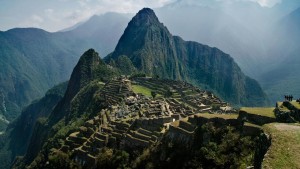
South America is a mix of European languages, colonial churches, secular politicians, beach culture and exotics. It is a colorful, sparkling carnival, a cool breeze blowing through the Andes, a fiery Argentine tango and the soft silence of the Ecuadorian rainforest. South America is full of attractions – from the rocky slopes of the Galapagos to the ruins of Machu Picchu. South America is one of the hottest tourist destinations, especially for enterprising people.
If you are going to travel there, include the best places to visit in South America in your must-see list. It is not an easy task to choose the most famous geographical objects of South America as there are a lot of outstanding landscape complexes. Many of them, preserving their centuries-old pristine nature, are under the protection of UNESCO. Let’s try to highlight the most popular and world-famous South American geographic objects here.
Contents
- Place to visit number 1: Machu Picchu or The Lost City of the Incas
- Place to visit number 2: Nazca, Peru
- Place to visit number 3 Galapagos Islands, Ecuador
- Place to visit number 4: San Pedro de Atacama, Chile
- Place to visit number 5: Salar de Uyuni, Bolivia
- Place to visit number 6: Titicaca, Peru and Bolivia
- Place to visit number 7: Torres-Del-Paine National Park, Chile
- Place to visit number 8: Perito-Moreno, Argentina
- Place to visit number 9: Iguazu Falls, Argentine-Brazilian border
- Place to visit number 10: The Angel Falls, Venezuela
- Video
Place to visit number 1: Machu Picchu or The Lost City of the Incas
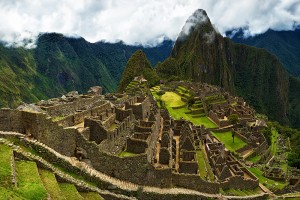 Machu Picchu is located at an altitude of just over 2 thousand meters above sea level, in Peruvian Cuzco. It is a sacred place, which was created in 1440 during the reign of severe Pachakutek. In 1532, when the Spanish conquerors came to the territory of the country, Machu Picchu did not suffer, in view of its inaccessibility. In the same year, the townspeople mysteriously disappeared, leaving in their compact settlement about 200 structures represented by:
Machu Picchu is located at an altitude of just over 2 thousand meters above sea level, in Peruvian Cuzco. It is a sacred place, which was created in 1440 during the reign of severe Pachakutek. In 1532, when the Spanish conquerors came to the territory of the country, Machu Picchu did not suffer, in view of its inaccessibility. In the same year, the townspeople mysteriously disappeared, leaving in their compact settlement about 200 structures represented by:
- temples,
- residences,
- public buildings.
Within Machu Picchu one can see the old city with its clear structure, winding streets of residential quarters, remains of temples and altar for Sacrifice. Good physical preparation will allow you to overcome the seemingly endless ladder leading to the “intuitan” – the stone to which the sun is tied.
Interesting: Machu Picchu is listed as a UNESCO World Heritage Site.
Back
Place to visit number 2: Nazca, Peru
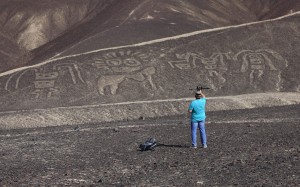 Nazca is the desert of the southern coast of Peru, famous for its geoglyphs, which represent geometric inscriptions on the surface of the plateau. Today, almost three dozen drawings resemble:
Nazca is the desert of the southern coast of Peru, famous for its geoglyphs, which represent geometric inscriptions on the surface of the plateau. Today, almost three dozen drawings resemble:
- animals (spider, hummingbird, monkey, lizard, pelican and even killer whale),
- plants (trees and flowers),
- and unusual shapes of fantastic figures.
In addition to this, the lands are disjointed by 13 thousand of lines and 7 hundreds of figures, together with hundreds of spiral ornaments. Features of the desert climatic zone allowed geoglyphs to live up to our days.
To distinguish the outlines while on the ground is problematic, since some of them reach hundreds of meters in length. The structure and harmony of the lines were discovered from a bird’s-eye view at the beginning of the last century. The attraction is a UNESCO World Heritage Site.
Interesting: The vast majority of the lines date back to 200 BC, and the earliest lines date almost 500 BC.
Back
Place to visit number 3: Galapagos Islands, Ecuador
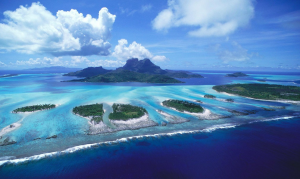 When talking about the most impressive countries in South America, the Republic of Ecuador certainly becomes one of the favorites. If you visit Ecuador, be sure to look at the amazing Galapagos Islands. Officially the islands were opened in March 1535 by the priest Thomas de Berlang, who sailed on a ship from Panama to Peru, but lost his course. The famous traveler Tour Heyerdahl visited this place in 1953 in search of the legacy of the famous Incas.
When talking about the most impressive countries in South America, the Republic of Ecuador certainly becomes one of the favorites. If you visit Ecuador, be sure to look at the amazing Galapagos Islands. Officially the islands were opened in March 1535 by the priest Thomas de Berlang, who sailed on a ship from Panama to Peru, but lost his course. The famous traveler Tour Heyerdahl visited this place in 1953 in search of the legacy of the famous Incas.
The oldest of the islands is about 10 million years old, and the youngest Isabela and Fernandina are still forming, eruptions occurred not so long ago, in 2005. They have the status of the National Park, and once were a refuge of convicts, today they are part of the UNESCO World Heritage Site and the protected area of the world biosphere. This place is noteworthy because of its natural and animal world of the endemic nature. Each of the Galapagos Islands in unique.
The Galapagos Islands are famous for their natural beauty, there is a national park and a biological marine reserve, where you can find out all about the flora and fauna of Ecuador. Flora and fauna of the islands are extremely unusual and diverse. The main plant in the Galapagos is the prickly pear cactus, which grows to a gigantic size.
There are only 9 species of mammals, but all of them are found exclusively in the Galapagos. Here one can see marine iguanas and sea lizards and the main decoration of the islands – giant Galapagos tortoises.
Galapagos turtles are among the record-long-livers of the world’s fauna. They live for 200 years or more. Feathered on the Galapagos archipelago are as many as 60 species, and half of them live only here.
Among the attractions of these places:
- the stunning Gulf of Bartolome,
- the island of Fernandina, where you will meet marine iguanas, penguins, sea lions and much more.
- On the island of Isabela giant turtles live, which can be seen all year round.
- The islands also offer scuba diving and swimming with dolphins.
Interesting: The Galapagos Islands are the Pacific archipelago to the west of Ecuador, includes a dozen volcanic formations, plus half a dozen of ordinary islets, along with 107 rocky and inundated lands.
Back
Place to visit number 4: San Pedro de Atacama, Chile
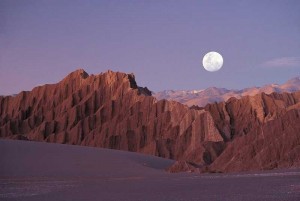 Narrow streets of this old city are home to mystical ancient cultures and all the attributes of modern tourism.
Narrow streets of this old city are home to mystical ancient cultures and all the attributes of modern tourism.
Some interesting facts making this place one of the favorite tourist destinations:
- The city is located 102 km from the city of Calama (the nearest town), the land around San Pedro de Atacama is owned by indigenous peoples engaged in agriculture and tourism.
- Its Old Town Square has a church (built in 1774), which is built in local architectural style: wood, adobe and leather bindings of beams.
- Nearby you will find the Archaeological Museum of Gustav Le Page where you can admire the mummies and household items that offer a glimpse into the region’s rich past.
You can also enjoy a wonderful view of the geothermal area at dawn, the geysers are one of the most popular tourist attractions of the area. On the way back – treat yourself to a relaxing visit to hot springs. It is a pure delight!
Interesting: The unique combination of past and present has made San Pedro one of the most photographed places in specialized magazines.
Back
Place to visit number 5: Salar de Uyuni, Bolivia
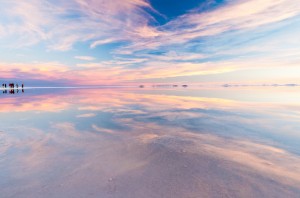 Salar de Uyuni is one of the most unique and beautiful places in the world. In a 45-minute drive from Uyuni you will meet the world’s largest salt marsh in the world – 10,000 square kilometers.
Salar de Uyuni is one of the most unique and beautiful places in the world. In a 45-minute drive from Uyuni you will meet the world’s largest salt marsh in the world – 10,000 square kilometers.
During the wet season, the salt desert turns into a large salt lake a few centimeters deep. Visitors can travel through the lake on boats or trucks. During this time of year, the lake reflects the sky, creating the illusion of infinity.
Here you can have great time doing the following things:
- see the peaks of the Andes,
- take a bath in the warm water of the lakes that are next to the geysers in the area.
Salar de Uyuni also promises one of the best sunsets in the world. It is a surreal but very beautiful place and very “photogenic”. The hotels here are built from salt blocks taken directly from Salar.
Interesting: The train cemetery and abandoned tracks are the main tourist attractions, and they are definitely worth a visit if you are in this area.
Back
Place to visit number 6: Titicaca, Peru and Bolivia
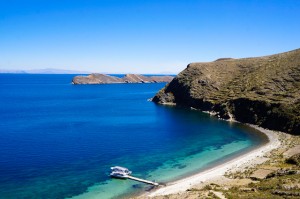 Titicaca is the largest lake in South America, which is located in the territories of Peru and Bolivia, at an altitude of about 4 thousand meters. It is the highest shipping lake on the planet. It is revered as sacred. It’s peculiar, because its two halves are quite different. It connects the “twins” of the Tikin Strait. The big water area is called Lago Grande, the smaller is Lago Peceno.
Titicaca is the largest lake in South America, which is located in the territories of Peru and Bolivia, at an altitude of about 4 thousand meters. It is the highest shipping lake on the planet. It is revered as sacred. It’s peculiar, because its two halves are quite different. It connects the “twins” of the Tikin Strait. The big water area is called Lago Grande, the smaller is Lago Peceno.
You may wonder what you can see coming to the lake, except for the vastness of the watery surface? Andes! And also 41 differently-sized islands, the largest of which is the Island of the Sun. On Sunny Island there are up to 180 different ruins, which are 500 years old! It is quite logical that to the east there is also the Island of the Moon, on which there are also many ancient ruins.
Lake Titicaca is considered the cradle of Inca civilization, Teotihuacan and other Andean peoples. According to the mythology of the Incas, one day the world was plunged into the abyss of darkness and cold, and the human race was on the verge of extinction. Some time after the flood, the god Viracocha came out from the depths of Lake Titicaca.
Traveling along the islands of the lake, Viracochi ordered to ascend the Sun and the Moon. He created anew a man and a woman and sent them on all four sides, starting the settling of the world. Thus, Titicaca is considered the birthplace of the Inca civilization, whose spirits returned back to the lake after death. For a long time, Titicaca was haunted by scientists who were searching for an underwater city named Wanaka, in which, according to legend, the Inca gold was hidden. In 1968, the famous Jacques Yves-Cousteau descended to the bottom of the lake to find at least some signs of the sunken city. Nevertheless, he discovered only ancient pottery. Only in 2000, local archaeologists discovered the ruins of the temple at the bottom of the lake. According to preliminary estimates, it is the remains of the once existing Tiwanaku civilization on this site, which existed before the Inca civilization was born.
Each tourist has the island of Takville in a list of must see places. Here you will not find electricity, cars and other benefits of civilization, and the locals profess the rule of the three not:
- do not lie,
- do not steal,
- do not be lazy.
Here, you will enjoy crystal clear air, stunning panoramas throughout the day, and the night sky completely covered by stars – from horizon to horizon.
Interesting: Lake Titicaca was formed due to precipitation, meltwater from glaciers in the Sierra Mountains.
Back
Place to visit number 7: Torres-Del-Paine National Park, Chile
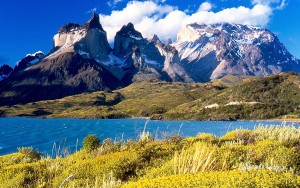 Chilean Patagonia is full of beautiful natural wonders. One of them you should not miss is the UNESCO Biosphere Reserve Torres del Paine, the most impressive landmark in the southern hemisphere, with a number of classic world hiking trails.
Chilean Patagonia is full of beautiful natural wonders. One of them you should not miss is the UNESCO Biosphere Reserve Torres del Paine, the most impressive landmark in the southern hemisphere, with a number of classic world hiking trails.
The park is located in the largest southern region of Chile and the Chilean Antarctic, where the main economic activities are sheep breeding, oil production and tourism. The park covers:
- ancient forests,
- glaciers,
- rivers,
- lakes and fjords,
- fauna including guanacos, foxes, cougars and a variety of birds.
Interesting: The Park attracts approximately 100,000 visitors each year, who visit Paine Towers, Los Cuernos, the French Valley and the Gray Glacier.
Back
Place to visit number 8: Perito-Moreno, Argentina
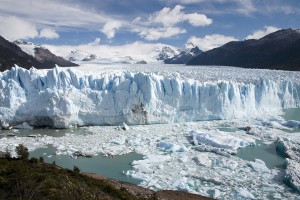 The Perito Moreno Glacier, located in Los Glyareas National Park in Patagonia, in the southern part of the Argentine desert, is widely known as one of the natural wonders of the world and is an integral part of any visit to the South America. Curiously, the mass loss of the glacier and the magnitude of the newly formed ice in the feeding area are approximately equal, therefore Perito Moreno does not come and does not recede for 90 years!
The Perito Moreno Glacier, located in Los Glyareas National Park in Patagonia, in the southern part of the Argentine desert, is widely known as one of the natural wonders of the world and is an integral part of any visit to the South America. Curiously, the mass loss of the glacier and the magnitude of the newly formed ice in the feeding area are approximately equal, therefore Perito Moreno does not come and does not recede for 90 years!
Why is this place considered to be very impressive?
- Sometimes the glacier reaches Lake Argentina, forming a natural dam and thus dividing the lake into two halves.
- Due to lack of access, the water in the southern part of this lake rises 30 meters higher than in the other half. Soon the underwater part of Perito Moreno does not withstand the great pressure of water and breaks but the upper part remains untouched, being a kind of ice bridge.
- Over 250 square kilometers in size, Perito Moreno glacier is one of the three glaciers of Patagonia, which does not back down, and the ice field is the third largest in the world with fresh water reserves.
Named after the legendary Argentine explorer, Dr. Francisco R Moreno, the glacier begins its journey high in the southern part of the Patagonian glacier in the Andes. Huge pieces of ice regularly break off the glacier, and this is an exciting sight, as the ice moans and creaks until finally it falls into the lake. The debris is 5 km wide and almost 80 meters high, so try to find a place where the next piece of ice will fall!
Interesting: The glacier moves at a speed of 2 meters a day.
Back
Place to visit number 9: Iguazu Falls, Argentine-Brazilian border
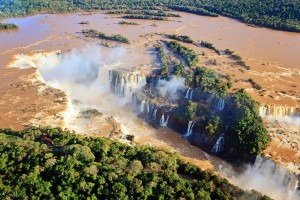 Iguazu Falls is one of the largest waterfall complexes in the world that is located on the Argentine-Brazilian border, 320 km east of the city of Asuncion in Paraguay, at the intersection of the Iguazu and Parana rivers.
Iguazu Falls is one of the largest waterfall complexes in the world that is located on the Argentine-Brazilian border, 320 km east of the city of Asuncion in Paraguay, at the intersection of the Iguazu and Parana rivers.
Things each tourist should know about Iguazu Falls:
- It was opened in 1541 by the Spanish conquistador Alvaro Núñez Cáseso de Vaca. Alvaro went to the jungle in order to find gold. In fact, he found it, only in a figurative sense, because the waterfalls of Iguazu are considered one of the main attractions of Brazil and Argentina.
- The name of the waterfall comes from the language of Guarani and in translation means “big water”. And there is nothing surprising. Approximately once in forty years during a drought, Iguazu completely dries up, and at that time the waterfall also disappears, and only the rock remains.
- The last time the drought was in 2006. Now, on the contrary, the authorities are concerned about the high level of water in the river, therefore, due to the threat to the safety of tourists, the approach to the famous “Devil’s Throat”, the most famous waterfall of the complex, was closed.
If the Iguazu cascades were a single, uninterrupted wall of water, it would be the widest waterfall in the world, but this is not so and today the widest continuous water wall is possessed by the African Victoria Falls. In order not to dwell only on waterfalls, take a tour of the Iguazu National Park to see the real jungle with its virgin flora and fauna.
Interesting: The average volume of water falling from above is 1.2 million cubic meters per second.
Place to visit number 10: The Angel Falls, Venezuela
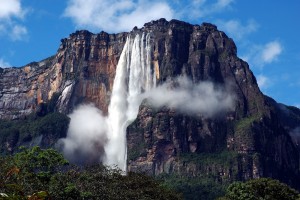 The Angel Falls is the highest waterfall in the world, the water flow of Angel has to fly almost a kilometer to reach the land. The waterfall is in the tropical forests of Venezuela, in the territory of the Canaima National Park.
The Angel Falls is the highest waterfall in the world, the water flow of Angel has to fly almost a kilometer to reach the land. The waterfall is in the tropical forests of Venezuela, in the territory of the Canaima National Park.
Interesting facts about the discovery of the Angel Falls:
- It was opened in 1935 by the American pilot and gold digger James Crawford Angel, although it was first discovered in 1910 by Spaniard Ernesto Sanchez La Cruz.
- Angel flew over the terrain in search of gold, when he decided to land on the top of one mountain.
- There he saw a huge waterfall falling from the cliff with a roar. Soon everyone learned about the new waterfall, which was named after the pilot who discovered it.
To reach the waterfall is not so easy as the Angel Falls is located in the wilderness of Venezuela. The trip to the waterfall includes a flight by plane from the city of Caracas or Ciudad Bolivar to Canaima, and then another crossing on the water. To foresee whether the waterfall will be seen is very difficult, since this area is often covered with fogs.
Interesting: The Angel Falls is 20 times higher than Niagara Falls and this is really impressive.
Back